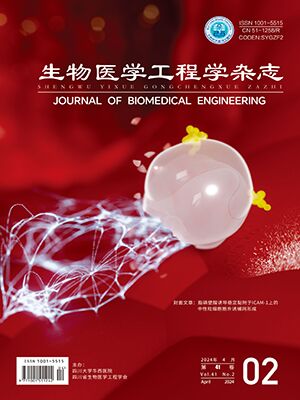| 1. |
Bargmann C I, Newsome W T. The brain research through advancing innovative neurotechnologies (BRAIN) initiative and neurology. JAMA Neurol, 2014, 71(6): 675-676.
|
| 2. |
Brühl A B. Making sense of real-time functional magnetic resonance imaging (rtfMRI) and rtfMRI neurofeedback. Int J Neuropsychopharmacol, 2015, 18(6): pyv020..
|
| 3. |
Thibault R T, Lifshitz M, Raz A. The self-regulating brain and neurofeedback: Experimental science and clinical promise. Cortex, 2016, 74: 247-261.
|
| 4. |
Stoeckel L E, Garrison K A, Ghosh S, et al. Optimizing real time fMRI neurofeedback for therapeutic discovery and development. Neuroimage Clin, 2014, 5: 245-255.
|
| 5. |
Birbaumer N, Ruiz S, Sitaram R. Learned regulation of brain metabolism. Trends Cogn Sci, 2013, 17(6): 295-302.
|
| 6. |
Scheinost D, Stoica T, Saksa J, et al. Orbitofrontal cortex neurofeedback produces lasting changes in contamination anxiety and resting-state connectivity. Transl Psychiatry, 2013, 3(4): e250.
|
| 7. |
Robineau F, Rieger S W, Mermoud C, et al. Self-regulation of inter-hemispheric visual cortex balance through real-time fMRI neurofeedback training. Neuroimage, 2014, 100: 1-14.
|
| 8. |
Arns M, Heinrich H, Strehl U. Evaluation of neurofeedback in ADHD: The long and winding road. Biol Psychol, 2014, 95(SI): 108-115.
|
| 9. |
Esmail S, Linden D E J. Neural networks and neurofeedback in Parkinson's disease. NeuroRegulation, 2014, 1(3/4): 240.
|
| 10. |
Thibault R T, Lifshitz M, Birbaumer N, et al. Neurofeedback, self-regulation, and brain imaging: clinical science and fad in the service of mental disorders. Psychother Psychosom, 2015, 84(4): 193-207.
|
| 11. |
Cannon R L. Editorial perspective: Defining neurofeedback and its functional processes. NeuroRegulation, 2015, 2(2): 60-69.
|
| 12. |
Linden D E. Neurofeedback and networks of depression. Dialogues Clin Neurosci, 2014, 16(1): 103-112.
|
| 13. |
Ruiz S, Lee S, Soekadar S R, et al. Acquired self-control of insula cortex modulates emotion recognition and brain network connectivity in schizophrenia. Hum Brain Mapp, 2013, 34(1): 200-212.
|
| 14. |
Mulders P C, van Eijndhoven P F, Schene A H, et al. Resting-state functional connectivity in major depressive disorder: A review. Neurosci Biobehav Rev, 2015, 56: 330-344.
|
| 15. |
Jie Biao, Zhang Daoqiang, Wee C Y, et al. Topological graph kernel on multiple thresholded functional connectivity networks for mild cognitive impairment classification. Hum Brain Mapp, 2014, 35(7): 2876-2897.
|
| 16. |
吕柄江, 赵小杰, 姚力, 等. 实时功能磁共振成像及其应用. 科学通报, 2014, 59(2): 195-209.
|
| 17. |
Cox R W, Jesmanowicz A, Hyde J S. Real-time functional magnetic resonance imaging. Magn Reson Med, 1995, 33(2): 230-236.
|
| 18. |
Weiskopf N, Veit R, Erb M, et al. Physiological self-regulation of regional brain activity using real-time functional magnetic resonance imaging (fMRI): Methodology and exemplary data. Neuroimage, 2003, 19(3): 577-586.
|
| 19. |
Sulzer J, Haller S, Scharnowski F, et al. Real-time fMRI neurofeedback: Progress and challenges. Neuroimage, 2013, 76(1): 386-399.
|
| 20. |
李椋. 基于实时功能磁共振成像的脑机接口技术研究. 郑州: 信息工程大学, 2014.
|
| 21. |
Brühl A B, Scherpiet S, Sulzer J, et al. Real-time neurofeedback using functional MRI could improve down-regulation of amygdala activity during emotional stimulation: A proof-of-concept study. Brain Topogr, 2014, 27(1): 138-148.
|
| 22. |
deCharms R C, Christoff K, Glover G H, et al. Learned regulation of spatially localized brain activation using real-time fMRI. Neuroimage, 2004, 21(1): 436-443.
|
| 23. |
Li Baojuan, Liu Li, Friston K J, et al. A treatment-resistant default mode subnetwork in major depression. Biol Psychiatry, 2013, 74(1): 48-54.
|
| 24. |
胡德文, 沈辉. 脑磁共振影像数据时空分析. 北京: 科学出版社, 2014: 133-176.
|
| 25. |
Zotev V, Phillips R, Young K D, et al. Prefrontal control of the amygdala during real-time fMRI neurofeedback training of emotion regulation. PLoS One, 2013, 8(11): e79184.
|
| 26. |
Paret C, Ruf M, Gerchen M F, et al. fMRI neurofeedback of amygdala response to aversive stimuli enhances prefrontal-limbic brain connectivity. Neuroimage, 2016, 125: 182-188.
|
| 27. |
Kadosh K C, Luo Qiang, de Burca C, et al. Using real-time fMRI to influence effective connectivity in the developing emotion regulation network. Neuroimage, 2016, 125: 616-626.
|
| 28. |
Ruiz S, Rana M, Sass K, et al. Brain network connectivity and behaviour enhancement: a fMRI-BCI study//17th Annual Meeting of the Organization for Human Brain Mapping. Quebec City: The Organization for Human Brain Mapping, 2011.
|
| 29. |
Megumi F, Yamashita A, Kawato M, et al. Functional MRI neurofeedback training on connectivity between two regions induces long-lasting changes in intrinsic functional network. Front Hum Neurosci, 2015, 9: 160.
|
| 30. |
Koush Y, Rosa M J, Robineau F, et al. Connectivity-based neurofeedback: Dynamic causal modeling for real-time fMRI. Neuroimage, 2013, 81: 422-430.
|
| 31. |
Koush Y, Meskaldji D E, Pichon S, et al. Learning control over emotion networks through connectivity-based neurofeedback. Cereb Cortex, 2017, 27(2): 1193-1202.
|
| 32. |
Ruiz S, Buyukturkoglu K, Rana M, et al. Real-time fMRI brain computer interfaces: Self-regulation of single brain regions to networks. Biol Psychol, 2014, 95(SI): 4-20.
|
| 33. |
童莉, 王理军, 郑载舟, 等. 基于多体素模式分析的 fMRI 视觉解码研究综述. 信息工程大学学报, 2015, 16(1): 66-72.
|
| 34. |
Li Zhonglin, Tong Li, Guan Min, et al. Altered resting-state amygdala functional connectivity after real-time fMRI emotion self-regulation training. Biomed Res Int, 2016, 2016: 1-8.
|
| 35. |
Li Zhonglin, Tong Li, Wang Linyuan, et al. Self-regulating positive emotion networks by feedback of multiple emotional brain states using real-time fMRI. Exp Brain Res, 2016, 234(12): 3575-3586.
|
| 36. |
Li Xiaofei, Yao Li, Ye Qing, et al. Online spatial normalization for real-time fMRI. PLoS One, 2014, 9(7): e103302.
|




